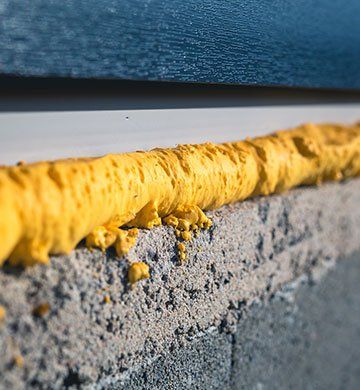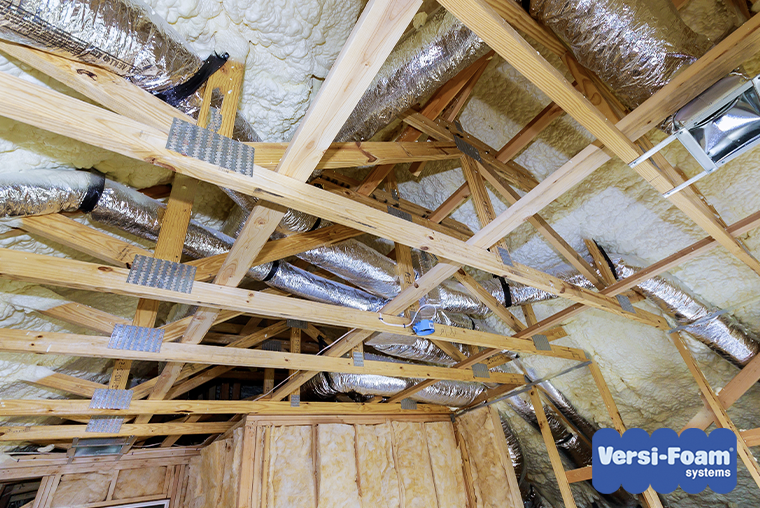Tips for Preserving Your Spray Foam Insulation for Long-Term Performance
Tips for Preserving Your Spray Foam Insulation for Long-Term Performance
Blog Article
Spray Foam: The Ultimate Solution for Air Sealing and Insulation
Spray foam insulation has emerged as a leading remedy for reliable air securing and thermal insulation, using a special mix of residential properties that establish it apart from conventional methods. Understanding the complete range of its benefits, installation procedures, and comparisons with other insulation kinds is critical for making informed decisions.
What Is Spray Foam?
Spray foam is a functional insulation product that combines the concepts of air securing and thermal resistance to enhance power effectiveness in buildings. Composed largely of polyurethane or other similar substances, spray foam is applied as a fluid that increases upon contact with surfaces, developing a solid, continual layer of insulation. This special home permits it to fill voids, cracks, and gaps that conventional insulation products may overlook, supplying an exceptional air seal.
There are 2 primary kinds of spray foam: open-cell and closed-cell. Open-cell spray foam is lighter and much more adaptable, using excellent noise absorption and a reduced R-value per inch - Spray Foam. On the other hand, closed-cell spray foam is denser, supplying a higher R-value, wetness resistance, and included structural integrity to developing components
The application process typically includes specialized equipment, making sure a smooth application that complies with numerous substrates, including timber, concrete, and metal. This flexibility makes spray foam appropriate for both brand-new constructions and retrofitting existing structures. Its capability to develop an airtight barrier dramatically contributes to decreasing power usage and boosting interior air quality, thus making it a favored selection amongst home builders and homeowners alike.
Advantages of Spray Foam Insulation
Among one of the most substantial benefits of spray foam insulation is its extraordinary capacity to develop a continual air obstacle, which properly minimizes energy loss. Unlike traditional insulation materials, spray foam expands to fill up spaces and fractures, making sure that air leakage is significantly lowered. This characteristic not just improves power performance but likewise causes reduce utility bills over time.
Additionally, spray foam insulation provides superior thermal resistance, adding to an extra secure indoor environment. Its high R-value per inch permits reliable insulation in restricted areas, making it suitable for attics, walls, and crawl rooms. In addition, the moisture-resistant homes of spray foam help protect against mold and mildew and mildew growth, advertising healthier living conditions.
An additional important benefit of spray foam insulation is its sound-dampening qualities (Spray Foam). It properly decreases sound transmission between areas, producing a quieter and much more comfy home atmosphere. The resilience of spray foam additionally sticks out, as it does not droop or clear up over time, keeping its performance throughout its life-span
How Spray Foam Works
Understanding how spray foam insulation works is important for valuing its effectiveness in air securing and thermal resistance. Spray foam insulation includes 2 main components: isocyanate and polyol material. When these parts are blended, they undertake a chemical reaction that triggers the product to expand quickly, developing a dense foam that fills up voids, cracks, and tooth cavities.
As the foam expands, it complies with surface areas, creating an impermeable seal that substantially lowers air seepage. This characteristic makes spray foam insulation highly efficient at protecting against drafts and moisture infiltration, which can bring about power loss and damages over time. In addition, the closed-cell variation of spray foam offers premium thermal resistance because of its inflexible framework, properly minimizing heat transfer.
The unique residential properties of spray foam permit it to adapt irregular surfaces, ensuring comprehensive insurance coverage and a seamless barrier. Consequently, spray foam insulation not only enhances power performance yet additionally adds to boosted interior air high quality by minimizing the build-up of allergens and pollutants. Inevitably, recognizing the technicians behind spray foam highlights its role as a superior selection for insulation and air securing in both commercial and residential applications.
Installment Process Overview

Before installment, the room must be effectively cleaned and prepped, guaranteeing that surface areas are free from moisture, debris, and dust. This action is critical because contaminants can jeopardize bond and general efficiency. When the location is prepared, the application entails blending both parts of the spray foam, which expands upon contact and fills gaps effectively.
Trained professionals ought to carry out the setup, using specific equipment to guarantee uniform protection and ideal density. Security safety measures, including wearing protective equipment and making certain correct air flow, are essential during this procedure. After application, the foam normally remedies rapidly, forming a solid obstacle that boosts power effectiveness.
Comparing Spray Foam to Traditional Insulation
When evaluating insulation alternatives, spray foam insulation sticks out in comparison to conventional products such as fiberglass and cellulose. Among the main advantages of spray foam is its premium air securing capabilities. Unlike fiberglass and cellulose, which can permit air seepage, spray foam expands upon application, loading crevices and spaces to create an impermeable seal. This causes enhanced power effectiveness, as much less warmed or cooled air runs away the home, causing lower energy bills.
In addition, spray foam offers a greater R-value per inch than traditional insulation kinds, offering even more effective thermal resistance in a thinner profile. This particular is especially advantageous precede with restricted tooth cavity deepness. Additionally, spray foam is immune to moisture and mold and mildew development, which can be a considerable interest in cellulose and fiberglass, especially in humid atmospheres.
Nonetheless, spray foam insulation generally brings a greater ahead of time price than its conventional equivalents. Homeowners must evaluate this initial financial investment versus long-term energy cost savings and efficiency benefits. Inevitably, while both insulation types offer their function, spray foam arises as a more sophisticated option for modern-day insulation demands, particularly in regards to air sealing and thermal effectiveness.

Conclusion
In recap, spray foam insulation stands for an extremely reliable solution for achieving ideal air securing and thermal resistance. basics Its one-of-a-kind buildings, consisting of dampness resistance and noise dampening, make it ideal for various applications in both new buildings and retrofitting jobs (Spray Foam). Although the first expenses may be higher contrasted to conventional insulation products, the long-lasting advantages, such as substantial energy financial savings and improved interior air high quality, go justify the investment and emphasize its value in modern building techniques.
Spray foam insulation has emerged as a leading service for reliable air sealing and thermal insulation, providing an one-of-a-kind mix of homes that establish it apart from traditional methods.Spray foam is a versatile insulation material that combines the principles of air sealing and thermal resistance to boost energy performance in buildings.When reviewing insulation alternatives, spray foam insulation stands out in contrast to traditional products such as fiberglass and cellulose. Eventually, while both insulation types serve their objective, spray foam arises as an extra innovative service for modern insulation demands, particularly in terms i thought about this of air sealing and thermal performance.
In summary, spray foam insulation stands for a very reliable service for accomplishing optimum air sealing and thermal resistance.
Report this page